From Wikipedia, the free encyclopedia
This article is about general aspects of water. For a detailed discussion of its properties, see Properties of water. For other uses, see Water (disambiguation).

Water in three states: liquid, solid (ice), and (invisible) water vapor in the air. Clouds are accumulations of water droplets, condensed from vapor-saturated air.
Water covers 70.9% of the Earth's surface,[3] and is vital for all known forms of life.[4] On Earth, it is found mostly in oceans and other large water bodies, with 1.6% of water below ground in aquifers and 0.001% in the air as vapor, clouds (formed of solid and liquid water particles suspended in air), and precipitation.[5] Oceans hold 97% of surface water, glaciers and polar ice caps 2.4%, and other land surface water such as rivers, lakes and ponds 0.6%. A very small amount of the Earth's water is contained within biological bodies and manufactured products.
Water on Earth moves continually through a cycle of evaporation or transpiration (evapotranspiration), precipitation, and runoff, usually reaching the sea. Over land, evaporation and transpiration contribute to the precipitation over land.
Clean drinking water is essential to humans and other lifeforms. Access to safe drinking water has improved steadily and substantially over the last decades in almost every part of the world.[6][7] There is a clear correlation between access to safe water and GDP per capita.[8] However, some observers have estimated that by 2025 more than half of the world population will be facing water-based vulnerability.[9] A recent report (November 2009) suggests that by 2030, in some developing regions of the world, water demand will exceed supply by 50%.[10] Water plays an important role in the world economy, as it functions as a solvent for a wide variety of chemical substances and facilitates industrial cooling and transportation. Approximately 70% of freshwater is consumed by agriculture.[11]
Contents[hide] |
Chemical and physical properties

Model of hydrogen bonds between molecules of water

Impact from a water drop causes an upward "rebound" jet surrounded by circular capillary waves.
Water appears in nature in all three common states of matter and may take many different forms on Earth: water vapor and clouds in the sky; seawater and icebergs in the polar oceans; glaciers and rivers in the mountains; and the liquid in aquifers in the ground.
At high temperatures and pressures, such as in the interior of giant planets, it is argued that water exists as ionic water in which the molecules break down into a soup of hydrogen and oxygen ions, and at even higher pressures as superionic water in which the oxygen crystallises but the hydrogen ions float around freely within the oxygen lattice.[12]
The major chemical and physical properties of water are:
- Water is a liquid at standard temperature and pressure. It is tasteless and odorless. The intrinsic color of water and ice is a very slight blue hue, although both appear colorless in small quantities. Water vapor is essentially invisible as a gas.[13]
- Water is transparent in the visible electromagnetic spectrum. Thus aquatic plants can live in water because sunlight can reach them. Ultra-violet and infrared light is strongly absorbed.
- Since the water molecule is not linear and the oxygen atom has a higher electronegativity than hydrogen atoms, it carries a slight negative charge, whereas the hydrogen atoms are slightly positive. As a result, water is a polar molecule with an electrical dipole moment. Water also can form an unusually large number of intermolecular hydrogen bonds (four) for a molecule of its size. These factors lead to strong attractive forces between molecules of water, giving rise to water's high surface tension[14] and capillary forces. The capillary action refers to the tendency of water to move up a narrow tube against the force of gravity. This property is relied upon by all vascular plants, such as trees.[citation needed]
- Water is a good solvent and is often[quantify] referred to[by whom?] as the universal solvent. Substances that dissolve in water, e.g., salts, sugars, acids, alkalis, and some gases – especially oxygen, carbon dioxide (carbonation) are known as hydrophilic (water-loving) substances, while those that do not mix well with water (e.g., fats and oils), are known as hydrophobic (water-fearing) substances.
- All the major components in cells (proteins, DNA and polysaccharides) are also dissolved in water.
- Pure water has a low electrical conductivity, but this increases significantly with the dissolution of a small amount of ionic material such as sodium chloride.
- The boiling point of water (and all other liquids) is dependent on the barometric pressure. For example, on the top of Mt. Everest water boils at 68 °C (154 °F), compared to 100 °C (212 °F) at sea level. Conversely, water deep in the ocean near geothermal vents can reach temperatures of hundreds of degrees and remain liquid.
- Water has the second highest molar specific heat capacity of any known substance, after ammonia, as well as a high heat of vaporization (40.65 kJ·mol−1), both of which are a result of the extensive hydrogen bonding between its molecules. These two unusual properties allow water to moderate Earth's climate by buffering large fluctuations in temperature.
- The maximum density of water occurs at 3.98 °C (39.16 °F).[15] It has the anomalous property of becoming less dense, not more, when it is cooled down to its solid form, ice. It expands to occupy 9% greater volume in this solid state, which accounts for the fact of ice floating on liquid water.
- Its Density is 1,000 kg/m3 liquid (4 °C), and weighs 62.4 lb/ft.3 (917 kg/m3, solid). It weighs 8.3454 lb/gal. (US, liquid) [16]
- Water is miscible with many liquids, such as ethanol, in all proportions, forming a single homogeneous liquid. On the other hand, water and most oils are immiscible usually forming layers according to increasing density from the top. As a gas, water vapor is completely miscible with air.
- Water forms an azeotrope with many other solvents.
- Water can be split by electrolysis into hydrogen and oxygen.
- As an oxide of hydrogen, water is formed when hydrogen or hydrogen-containing compounds burn or react with oxygen or oxygen-containing compounds. Water is not a fuel, it is an end-product of the combustion of hydrogen. The energy required to split water into hydrogen and oxygen by electrolysis or any other means is greater than the energy that can be collected when the hydrogen and oxygen recombine.[17]
- Elements which are more electropositive than hydrogen such as lithium, sodium, calcium, potassium and caesium displace hydrogen from water, forming hydroxides. Being a flammable gas, the hydrogen given off is dangerous and the reaction of water with the more electropositive of these elements may be violently explosive.
Taste and odor
Water can dissolve many different substances, giving it varying tastes and odors. Humans and other animals have developed senses which enable them to evaluate the potability of water by avoiding water that is too salty or putrid. The taste of spring water and mineral water, often advertised in marketing of consumer products, derives from the minerals dissolved in it. However, pure H2O is tasteless and odorless. The advertised purity of spring and mineral water refers to absence of toxins, pollutants and microbes.Distribution in nature
In the universe
Much of the universe's water is produced as a byproduct of star formation. When stars are born, their birth is accompanied by a strong outward wind of gas and dust. When this outflow of material eventually impacts the surrounding gas, the shock waves that are created compress and heat the gas. The water observed is quickly produced in this warm dense gas.[18]Water has been detected in interstellar clouds within our galaxy, the Milky Way. Water probably exists in abundance in other galaxies, too, because its components, hydrogen and oxygen, are among the most abundant elements in the universe. Interstellar clouds eventually condense into solar nebulae and solar systems such as ours.
Water vapor is present in
- Atmosphere of Mercury: 3.4%, and large amounts of water in Mercury's exosphere[19]
- Atmosphere of Venus: 0.002%
- Earth's atmosphere: ~0.40% over full atmosphere, typically 1–4% at surface
- Atmosphere of Mars: 0.03%
- Atmosphere of Jupiter: 0.0004%
- Atmosphere of Saturn – in ices only
- Enceladus (moon of Saturn): 91%
- exoplanets known as HD 189733 b[20] and HD 209458 b.[21]
- Earth: 71% of surface
Water ice is present on
- Earth – mainly as ice sheets
- polar ice caps on Mars
- Moon
- Titan
- Europa
- Saturn's rings[22]
- Enceladus
- Pluto and Charon[22]
- Comets and comet source populations (Kuiper belt and Oort cloud objects).
Some of the Moon's minerals contain water molecules. For instance, in 2008 a laboratory device which ejects and identifies particles found small amounts of the compound in the inside of volcanic pearls brought from Moon to Earth by the Apollo 15 crew in 1971.[23] NASA reported the detection of water molecules by NASA's Moon Mineralogy Mapper aboard the Indian Space Research Organization's Chandrayaan-1 spacecraft in September 2009.[24]
Water and habitable zone
The existence of liquid water, and to a lesser extent its gaseous and solid forms, on Earth are vital to the existence of life on Earth as we know it. The Earth is located in the habitable zone of the solar system; if it were slightly closer to or farther from the Sun (about 5%, or about 8 million kilometers), the conditions which allow the three forms to be present simultaneously would be far less likely to exist.[25][26]Earth's gravity allows it to hold an atmosphere. Water vapor and carbon dioxide in the atmosphere provide a temperature buffer (greenhouse effect) which helps maintain a relatively steady surface temperature. If Earth were smaller, a thinner atmosphere would allow temperature extremes, thus preventing the accumulation of water except in polar ice caps (as on Mars).
The surface temperature of Earth has been relatively constant through geologic time despite varying levels of incoming solar radiation (insolation), indicating that a dynamic process governs Earth's temperature via a combination of greenhouse gases and surface or atmospheric albedo. This proposal is known as the Gaia hypothesis.
The state of water on a planet depends on ambient pressure, which is determined by the planet's gravity. If a planet is sufficiently massive, the water on it may be solid even at high temperatures, because of the high pressure caused by gravity, as it was observed on exoplanets Gliese 436 b[27] and GJ 1214 b.[28]
There are various theories about origin of water on Earth.
On Earth
Main articles: Hydrology and Water distribution on Earth

Water covers 71% of the Earth's surface; the oceans contain 97.2% of the Earth's water. The Antarctic ice sheet, which contains 61% of all fresh water on Earth, is visible at the bottom. Condensed atmospheric water can be seen as clouds, contributing to the Earth's albedo.
The collective mass of water found on, under, and over the surface of a planet is called the hydrosphere. Earth's approximate water volume (the total water supply of the world) is 1,360,000,000 km3 (326,000,000 mi3).
Groundwater and fresh water are useful or potentially useful to humans as water resources.
Liquid water is found in bodies of water, such as an ocean, sea, lake, river, stream, canal, pond, or puddle. The majority of water on Earth is sea water. Water is also present in the atmosphere in solid, liquid, and vapor states. It also exists as groundwater in aquifers.
Water is important in many geological processes. Groundwater is present in most rocks, and the pressure of this groundwater affects patterns of faulting. Water in the mantle is responsible for the melt that produces volcanoes at subduction zones. On the surface of the Earth, water is important in both chemical and physical weathering processes. Water and, to a lesser but still significant extent, ice, are also responsible for a large amount of sediment transport that occurs on the surface of the earth. Deposition of transported sediment forms many types of sedimentary rocks, which make up the geologic record of Earth history.
Water cycle
Main article: Water cycle
The water cycle (known scientifically as the hydrologic cycle) refers to the continuous exchange of water within the hydrosphere, between the atmosphere, soil water, surface water, groundwater, and plants.Water moves perpetually through each of these regions in the water cycle consisting of following transfer processes:
- evaporation from oceans and other water bodies into the air and transpiration from land plants and animals into air.
- precipitation, from water vapor condensing from the air and falling to earth or ocean.
- runoff from the land usually reaching the sea.
Water runoff often collects over watersheds flowing into rivers. A mathematical model used to simulate river or stream flow and calculate water quality parameters is hydrological transport model. Some of water is diverted to irrigation for agriculture. Rivers and seas offer opportunity for travel and commerce. Through erosion, runoff shapes the environment creating river valleys and deltas which provide rich soil and level ground for the establishment of population centers. A flood occurs when an area of land, usually low-lying, is covered with water. It is when a river overflows its banks or flood from the sea. A drought is an extended period of months or years when a region notes a deficiency in its water supply. This occurs when a region receives consistently below average precipitation.
Fresh water storage
Main article: Water resources
Some runoff water is trapped for periods of time, for example in lakes. At high altitude, during winter, and in the far north and south, snow collects in ice caps, snow pack and glaciers. Water also infiltrates the ground and goes into aquifers. This groundwater later flows back to the surface in springs, or more spectacularly in hot springs and geysers. Groundwater is also extracted artificially in wells. This water storage is important, since clean, fresh water is essential to human and other land-based life. In many parts of the world, it is in short supply.Sea water
Sea water contains about 3.5% salt on average, plus smaller amounts of other substances. The physical properties of sea water differ from fresh water in some important respects. It freezes at a lower temperature (about −1.9 °C) and its density increases with decreasing temperature to the freezing point, instead of reaching maximum density at a temperature above freezing. The salinity of water in major seas varies from about 0.7% in the Baltic Sea to 4.0% in the Red Sea.Tides
Tides are the cyclic rising and falling of local sea levels caused by the tidal forces of the Moon and the Sun acting on the oceans. Tides cause changes in the depth of the marine and estuarine water bodies and produce oscillating currents known as tidal streams. The changing tide produced at a given location is the result of the changing positions of the Moon and Sun relative to the Earth coupled with the effects of Earth rotation and the local bathymetry. The strip of seashore that is submerged at high tide and exposed at low tide, the intertidal zone, is an important ecological product of ocean tides.Effects on life

Overview of photosynthesis and respiration. Water (at right), together with carbon dioxide (CO2), form oxygen and organic compounds (at left), which can be respired to water and (CO2).
Water is fundamental to photosynthesis and respiration. Photosynthetic cells use the sun's energy to split off water's hydrogen from oxygen. Hydrogen is combined with CO2 (absorbed from air or water) to form glucose and release oxygen. All living cells use such fuels and oxidize the hydrogen and carbon to capture the sun's energy and reform water and CO2 in the process (cellular respiration).
Water is also central to acid-base neutrality and enzyme function. An acid, a hydrogen ion (H+, that is, a proton) donor, can be neutralized by a base, a proton acceptor such as hydroxide ion (OH−) to form water. Water is considered to be neutral, with a pH (the negative log of the hydrogen ion concentration) of 7. Acids have pH values less than 7 while bases have values greater than 7.
Aquatic life forms
Main articles: Hydrobiology and Aquatic plant
Earth's surface waters are filled with life. The earliest life forms appeared in water; nearly all fish live exclusively in water, and there are many types of marine mammals, such as dolphins and whales. Some kinds of animals, such as amphibians, spend portions of their lives in water and portions on land. Plants such as kelp and algae grow in the water and are the basis for some underwater ecosystems. Plankton is generally the foundation of the ocean food chain.Aquatic vertebrates must obtain oxygen to survive, and they do so in various ways. Fish have gills instead of lungs, although some species of fish, such as the lungfish, have both. Marine mammals, such as dolphins, whales, otters, and seals need to surface periodically to breathe air. Some amphibians are able to absorb oxygen through their skin. Invertebrates exhibit a wide range of modifications to survive in poorly oxygenated waters including breathing tubes (see insect and mollusc siphons) and gills (Carcinus). However as invertebrate life evolved in an aquatic habitat most have little or no specialisation for respiration in water.
Effects on human civilization

Water fountain
Health and pollution
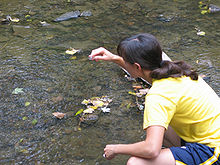
Environmental Science Program, Iowa State University student sampling water.
Water that is not fit for drinking but is not harmful for humans when used for swimming or bathing is called by various names other than potable or drinking water, and is sometimes called safe water, or "safe for bathing". Chlorine is a skin and mucous membrane irritant that is used to make water safe for bathing or drinking. Its use is highly technical and is usually monitored by government regulations (typically 1 part per million (ppm) for drinking water, and 1–2 ppm of chlorine not yet reacted with impurities for bathing water). Water for bathing may be maintained in satisfactory microbiological condition using chemical disinfectants such as chlorine or ozone or by the use of ultraviolet light.
In the USA, non-potable forms of wastewater generated by humans may be referred to as greywater, which is treatable and thus easily able to be made potable again, and blackwater, which generally contains sewage and other forms of waste which require further treatment in order to be made reusable. Greywater composes 50–80% of residential wastewater generated by a household's sanitation equipment (sinks, showers and kitchen runoff, but not toilets, which generate blackwater.) These terms may have different meanings in other countries and cultures.
This natural resource is becoming scarcer in certain places, and its availability is a major social and economic concern. Currently, about a billion people around the world routinely drink unhealthy water. Most countries accepted the goal of halving by 2015 the number of people worldwide who do not have access to safe water and sanitation during the 2003 G8 Evian summit.[29] Even if this difficult goal is met, it will still leave more than an estimated half a billion people without access to safe drinking water and over a billion without access to adequate sanitation. Poor water quality and bad sanitation are deadly; some five million deaths a year are caused by polluted drinking water. The World Health Organization estimates that safe water could prevent 1.4 million child deaths from diarrhea each year.[30] Water, however, is not a finite resource, but rather re-circulated as potable water in precipitation in quantities many degrees of magnitude higher than human consumption. Therefore, it is the relatively small quantity of water in reserve in the earth (about 1% of our drinking water supply, which is replenished in aquifers around every 1 to 10 years), that is a non-renewable resource, and it is, rather, the distribution of potable and irrigation water which is scarce, rather than the actual amount of it that exists on the earth. Water-poor countries use importation of goods as the primary method of importing water (to leave enough for local human consumption), since the manufacturing process uses around 10 to 100 times products' masses in water.
In the developing world, 90% of all wastewater still goes untreated into local rivers and streams.[31] Some 50 countries, with roughly a third of the world’s population, also suffer from medium or high water stress, and 17 of these extract more water annually than is recharged through their natural water cycles.[32] The strain not only affects surface freshwater bodies like rivers and lakes, but it also degrades groundwater resources.
Human uses
Further information: Water supply
Agriculture

Irrigation of field crops
Fifty years ago, the common perception was that water was an infinite resource. At this time, there were fewer than half the current number of people on the planet. People were not as wealthy as today, consumed fewer calories and ate less meat, so less water was needed to produce their food. They required a third of the volume of water we presently take from rivers. Today, the competition for water resources is much more intense. This is because there are now nearly seven billion people on the planet, their consumption of water-thirsty meat and vegetables is rising, and there is increasing competition for water from industry, urbanisation and biofuel crops. In future, even more water will be needed to produce food because the Earth's population is forecast to rise to 9 billion by 2050.[35] An additional 2.5 or 3 billion people, choosing to eat fewer cereals and more meat and vegetables could add an additional five million kilometres to the virtual canal mentioned above.
An assessment of water management in agriculture was conducted in 2007 by the International Water Management Institute in Sri Lanka to see if the world had sufficient water to provide food for its growing population.[36] It assessed the current availability of water for agriculture on a global scale and mapped out locations suffering from water scarcity. It found that a fifth of the world's people, more than 1.2 billion, live in areas of physical water scarcity, where there is not enough water to meet all demands. A further 1.6 billion people live in areas experiencing economic water scarcity, where the lack of investment in water or insufficient human capacity make it impossible for authorities to satisfy the demand for water. The report found that it would be possible to produce the food required in future, but that continuation of today's food production and environmental trends would lead to crises in many parts of the world. To avoid a global water crisis, farmers will have to strive to increase productivity to meet growing demands for food, while industry and cities find ways to use water more efficiently.[37]
As a scientific standard
On 7 April 1795, the gram was defined in France to be equal to "the absolute weight of a volume of pure water equal to a cube of one hundredth of a meter, and to the temperature of the melting ice."[38] For practical purposes though, a metallic reference standard was required, one thousand times more massive, the kilogram. Work was therefore commissioned to determine precisely the mass of one liter of water. In spite of the fact that the decreed definition of the gram specified water at 0 °C—a highly reproducible temperature—the scientists chose to redefine the standard and to perform their measurements at the temperature of highest water density, which was measured at the time as 4 °C (39 °F).[39]The Kelvin temperature scale of the SI system is based on the triple point of water, defined as exactly 273.16 K or 0.01 °C. The scale is an absolute temperature scale with the same increment as the Celsius temperature scale, which was originally defined according the boiling point (set to 100 °C) and melting point (set to 0 °C) of water.
Natural water consists mainly of the isotopes hydrogen-1 and oxygen-16, but there is also small quantity of heavier isotopes such as hydrogen-2 (deuterium). The amount of deuterium oxides or heavy water is very small, but it still affects the properties of water. Water from rivers and lakes tends to contain less deuterium than seawater. Therefore, standard water is defined in the Vienna Standard Mean Ocean Water specification.
For drinking
Main article: Drinking water

A young girl drinking bottled water

Hazard symbol for Not drinking water
Humans require water that does not contain too many impurities. Common impurities include metal salts and oxides (including copper, iron, calcium and lead)[48] and/or harmful bacteria, such as Vibrio. Some solutes are acceptable and even desirable for taste enhancement and to provide needed electrolytes.[49]
The single largest (by volume) freshwater resource suitable for drinking is Lake Baikal in Siberia.[50]
Washing
The propensity of water to form solutions and emulsions is useful in various washing processes. Many industrial processes rely on reactions using chemicals dissolved in water, suspension of solids in water slurries or using water to dissolve and extract substances. Washing is also an important component of several aspects of personal body hygiene.Chemical uses
Water is widely used in chemical reactions as a solvent or reactant and less commonly as a solute or catalyst. In inorganic reactions, water is a common solvent, dissolving many ionic compounds. In organic reactions, it is not usually used as a reaction solvent, because it does not dissolve the reactants well and is amphoteric (acidic and basic) and nucleophilic. Nevertheless, these properties are sometimes desirable. Also, acceleration of Diels-Alder reactions by water has been observed. Supercritical water has recently been a topic of research. Oxygen-saturated supercritical water combusts organic pollutants efficiently.Heat exchange

Ice used for cooling.
In the nuclear power industry, water can also be used as a neutron moderator. In most nuclear reactors, water is both a coolant and a moderator. This provides something of a passive safety measure, as removing the water from the reactor also slows the nuclear reaction down – however other methods are favored for stopping a reaction and it is preferred to keep the nuclear core covered with water so as to ensure adequate cooling.
Fire extinction
Water has a high heat of vaporization and is relatively inert, which makes it a good fire extinguishing fluid. The evaporation of water carries heat away from the fire. However, only distilled water can be used to fight fires of electric equipment, because impure water is electrically conductive. Water is not suitable for use on fires of oils and organic solvents, because they float on water and the explosive boiling of water tends to spread the burning liquid.Use of water in fire fighting should also take into account the hazards of a steam explosion, which may occur when water is used on very hot fires in confined spaces, and of a hydrogen explosion, when substances which react with water, such as certain metals or hot graphite, decompose the water, producing hydrogen gas.
The power of such explosions was seen in the Chernobyl disaster, although the water involved did not come from fire-fighting at that time but the reactor's own water cooling system. A steam explosion occurred when the extreme over-heating of the core caused water to flash into steam. A hydrogen explosion may have occurred as a result of reaction between steam and hot zirconium.
Recreation

Grand Anse Beach, St. George's, Grenada, West Indies, often reported as one of the top 10 beaches in the world.
Main article: Water sport (recreation)
Humans use water for many recreational purposes, as well as for exercising and for sports. Some of these include swimming, waterskiing, boating, surfing and diving. In addition, some sports, like ice hockey and ice skating, are played on ice. Lakesides, beaches and waterparks are popular places for people to go to relax and enjoy recreation. Many find the sound and appearance of flowing water to be calming, and fountains and other water features are popular decorations. Some keep fish and other life in aquariums or ponds for show, fun, and companionship. Humans also use water for snow sports i.e. skiing, sledding, snowmobiling or snowboarding, which requires the water to be frozen. People may also use water for play fighting such as with snowballs, water guns or water balloons.Water industry

A water-carrier in India, 1882. In many places where running water was not available, water had to be transported by people.

Water purification facility
Drinking water is often collected at springs, extracted from artificial borings (wells) in the ground, or pumped from lakes and rivers. Building more wells in adequate places is thus a possible way to produce more water, assuming the aquifers can supply an adequate flow. Other water sources include rainwater collection. Water may require purification for human consumption. This may involve removal of undissolved substances, dissolved substances and harmful microbes. Popular methods are filtering with sand which only removes undissolved material, while chlorination and boiling kill harmful microbes. Distillation does all three functions. More advanced techniques exist, such as reverse osmosis. Desalination of abundant seawater is a more expensive solution used in coastal arid climates.
The distribution of drinking water is done through municipal water systems, tanker delivery or as bottled water. Governments in many countries have programs to distribute water to the needy at no charge. Others[who?] argue that the market mechanism and free enterprise are best to manage this rare resource and to finance the boring of wells or the construction of dams and reservoirs.
Reducing usage by using drinking (potable) water only for human consumption is another option. In some cities such as Hong Kong, sea water is extensively used for flushing toilets citywide in order to conserve fresh water resources.
Polluting water may be the biggest single misuse of water; to the extent that a pollutant limits other uses of the water, it becomes a waste of the resource, regardless of benefits to the polluter. Like other types of pollution, this does not enter standard accounting of market costs, being conceived as externalities for which the market cannot account. Thus other people pay the price of water pollution, while the private firms' profits are not redistributed to the local population victim of this pollution. Pharmaceuticals consumed by humans often end up in the waterways and can have detrimental effects on aquatic life if they bioaccumulate and if they are not biodegradable.
Wastewater facilities are storm sewers and wastewater treatment plants. Another way to remove pollution from surface runoff water is bioswale.
Industrial applications
Water is used in power generation. Hydroelectricity is electricity obtained from hydropower. Hydroelectric power comes from water driving a water turbine connected to a generator. Hydroelectricity is a low-cost, non-polluting, renewable energy source. The energy is supplied by the sun. Heat from the sun evaporates water, which condenses as rain in higher altitudes, from where it flows down.Pressurized water is used in water blasting and water jet cutters. Also, very high pressure water guns are used for precise cutting. It works very well, is relatively safe, and is not harmful to the environment. It is also used in the cooling of machinery to prevent over-heating, or prevent saw blades from over-heating.
Water is also used in many industrial processes and machines, such as the steam turbine and heat exchanger, in addition to its use as a chemical solvent. Discharge of untreated water from industrial uses is pollution. Pollution includes discharged solutes (chemical pollution) and discharged coolant water (thermal pollution). Industry requires pure water for many applications and utilizes a variety of purification techniques both in water supply and discharge.
Food processing
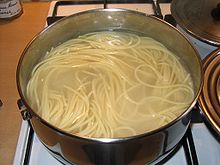
Water can be used to cook foods such as noodles.
Solutes such as salts and sugars found in water affect the physical properties of water. The boiling and freezing points of water are affected by solutes, as well as air pressure, which is in turn affected by altitude. Water boils at lower temperatures with the lower air pressure which occurs at higher elevations. One mole of sucrose (sugar) per kilogram of water raises the boiling point of water by 0.51 °C, and one mole of salt per kg raises the boiling point by 1.02 °C; similarly, increasing the number of dissolved particles lowers water's freezing point.[51] Solutes in water also affect water activity which affects many chemical reactions and the growth of microbes in food.[52] Water activity can be described as a ratio of the vapor pressure of water in a solution to the vapor pressure of pure water.[51] Solutes in water lower water activity. This is important to know because most bacterial growth ceases at low levels of water activity.[52] Not only does microbial growth affect the safety of food but also the preservation and shelf life of food.
Water hardness is also a critical factor in food processing. It can dramatically affect the quality of a product as well as playing a role in sanitation. Water hardness is classified based on the amounts of removable calcium carbonate salt it contains per gallon. Water hardness is measured in grains; 0.064 g calcium carbonate is equivalent to one grain of hardness.[51] Water is classified as soft if it contains 1 to 4 grains, medium if it contains 5 to 10 grains and hard if it contains 11 to 20 grains.[vague] [51] The hardness of water may be altered or treated by using a chemical ion exchange system. The hardness of water also affects its pH balance which plays a critical role in food processing. For example, hard water prevents successful production of clear beverages. Water hardness also affects sanitation; with increasing hardness, there is a loss of effectiveness for its use as a sanitizer.[51]
Boiling, steaming, and simmering are popular cooking methods that often require immersing food in water or its gaseous state, steam. Water is also used for dishwashing.
Water law, water politics and water crisis

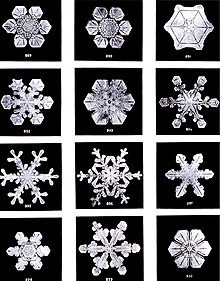

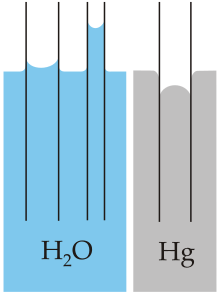

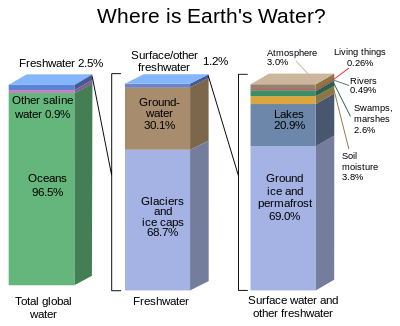





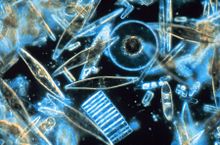


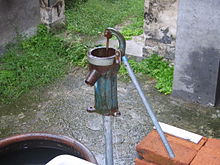

Tidak ada komentar:
Posting Komentar